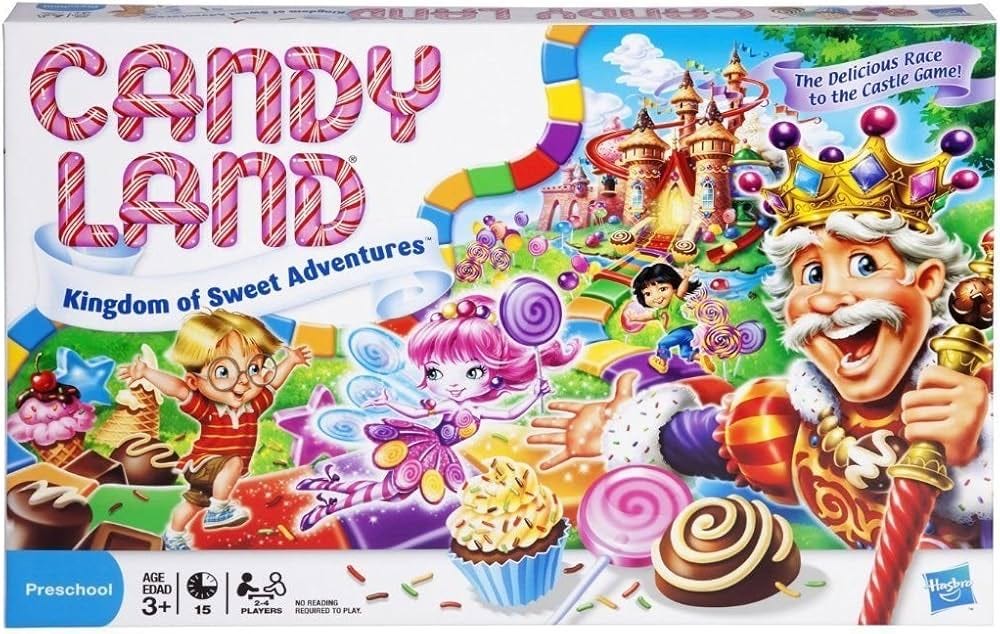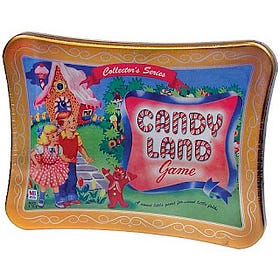I've had many conversations with friends where I have posited that the best introductory role playing games for younger players -- ages 5 to 9 -- are the Pokemon Jr. Adventure Game by Bill Slavicsek and Stan!, Faery's Tale by Patrick Sweeney, Sandy Antunes, Christina Stiles, Colin Chapman, and Robin D. Laws, RPG Kids by Enrique Bertran aka NewbieDM, and Hero Kids by Justin Halliday. Each of these games comes at introducing RPGs to younger players and their parents from a different perspective, and each is a wonderful addition to any gamer's collection. These games aren't merely good introductory games, they are also fun games for gamers of any age.
But there’s one game many of us overlook without a second thought, but it’s a game I added after years of experiencing it in action. It’s a game that will likely surprise some hobby gamers. The game is the much maligned Candy Land by Hasbro. Most hobby gamers look at Candy Land as a boring exercise in which the players have no influence over the flow of play, and as a game completely devoid of any kind of play strategy. Anyone who has played the game knows that the only actions a player takes are to draw a card and to move his/her pawn to the space signified by the drawn card. This simple randomized movement "track" game is so disliked that it has a rating of 3.21 on BoardGame Geek. A quick look at what a 3.2 rating means on BGG, let's us know that the BGG community thinks the game is Bad and not worth replaying. Even adjusting for BGG's strong anti-children's game bias by adding a point or so doesn't put this game into recommendable territory for most gamers.
Last December I defended Candy Land as a board game, and a quick look through the internet demonstrates that the game is a rich source for statistical analysis. Dave Rusin of Northern Illinois University and Lou Scheffer a researcher at the Howard Hughes Medical Institute (which I first heard about in Tim Harford's book Adapt1) have both written good analyses of the game from a statistical perspective, but it is the rigorous analysis at DataGenetics by Nick Berry which truly demonstrates just how deeply one can dig into the statistics of the game. When I defended the game back in December, I highlighted the pedagogical aspects of play in Candy Land. It is a wonderful game for teaching young people how to play games, and also aids in educating young players that not all victories come from "being better" than your opponent which helps to teach good sportsmanship.
What I only briefly mentioned in that post, was that Candy Land is a great role playing game as well. Back in December I stated that one of the joys of playing the game with my daughter's History and Mystery was that it engaged their imagination's in storytelling. I'm quite surprised that I didn't associate this with role playing and role playing games in that article, even though I described the way my daughters play the game as follows:
Rather than the goal of the game being to "go home" as is written in the rules, Mystery and History are on a journey to have tea at Hello Kitty's house. To add to the immersion, they have placed Lego Duplo "cat legos" on the board at both the home and peanut brittle house squares. The home square represents Hello Kitty's house and the peanut brittle house is the domicile of Hello Kitty's apocryphal twin sister "Boxie."
Re-reading the post made me realize how much like a role playing game session that sounds, but my daughters go even further than might be alluded to in the above description. History and Mystery also engaged in dialogue with the Duplo cats and have conversations with Hello Kitty and Boxie when they reach their destinations. In fact, it was more important to Mystery that her "Ginger Man" reach the Peanut Brittle square than winning the game. What's more is that they used the first person singular "I" when they refer to their gingerbread man pawn. The girls were completely immersed in the fictional world of Candy Land. Not only that, but they expanded the fantasy world to include their own imaginary components. It’s no wonder my daughters have come to love Dungeons & Dragons now that they are teens, nor that they’ve asked me to run the campaign for them and their friends.
As a parent it has been a real joy to watch my daughters engage in this kind of imaginative play and to watch it grow over the years. They also role played when they dressed up in their Iron Man and Captain America costumes, when they played with their Legos and cars as well as with various stuffed animals and dolls. They even did some early role playing when they borrowed my D&D and Star Wars miniatures.
It's been quite magnificent to watch, and it's truly amazing to see how well Candy Land creates a Salen/Zimmerman/Huizinga "magic circle" as well. It demonstrates it so well that like Zimmerman in his defense of the magic circle, I find criticisms like that by Darryl Woodford a little pendantic, overly literal, and odd. What is most interesting in my experience is that I get to see how the "magic circle" of play that my daughters created during games of Candy Land extended beyond the spaces on the board itself and that the imaginary land in which they played included implied spaces in the illustrations and their own imagined Candy Land environment. The Kingdom of Candy Land was a real place to them with real stories.
This imagining only extended until they stopped playing the game. Once the game stopped, they knew that they were no longer in Candy Land. They were ready to begin engaging with the real world and their foray's into "Elfland" (to borrow a phrase from Lord Dunsany) were finished and without the trauma or life changes that accompany many fictional representations of fantastic journeys. The magic circle allowed them to explore Wonderland without the risk of the Red Queen chopping off their heads. It was wonder to see.
I wish that I was the first person to describe Candy Land as a role playing game, but James Ernest in Family Games: The 100 Best -- and I'm sure countless others -- have beat me to it. As he described his play with his daughter Nora:
When I got "stuck on a gooey gumdrop," Nora would move her pawn back to that space and help me get unstuck. This completely surprised me, because as a grown-up I assumed that a race game is unfriendly. She would move back to her own space after helping me, but she always helped. And she expected this kind of socially responsible behavior out of her parents as well....
Anyone who thinks he has seen all of Candy Land ought to play it again with a child.
Candy Land may not be the pinnacle of role playing game systems, but it seems clear to me that my own "maturity as a gamer" is what got in the way of my enjoyment of this game for many years. Playing it with my daughters was a joy, and I am slightly saddened that I’ve come to the the day when Candy Land no longer creates a magic circle where my daughters are imagining a realistic milieu. It is Dungeons & Dragons that now fills that hole, but maybe I’ll ask them to return to Candy Land this Christmas season, with some rules modifications to accommodate them as experienced gamers.
This won’t be the last time I wander into the Kingdom of Candy Land in this space and I’ll be sharing some of my house rules soon. There is a big part of me that thinks it is a tragedy when adults believe that spending some time wandering the fields of Elfland is a waste of time or silly.
Tim Harford has a deep connection to the Dragon Warriors role playing game, which is a nice bit of serendipity.








Candyland is a classic!